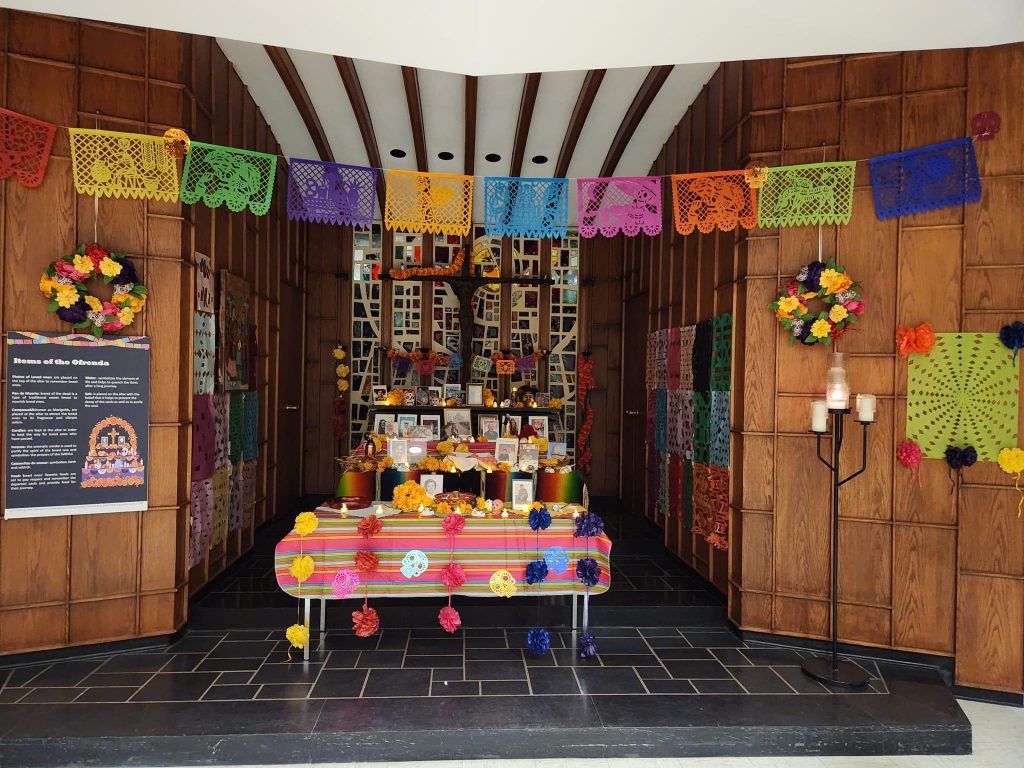When our loved ones die

This week many Christians will gather to commemorate All Saints Day. It’s an ancient Christian practice: setting aside a day to remember and honor those who have died in the faith. At the Chapel we’ll gather photos of those from our Valpo community who have died in the last year, and we’ll arrange them around the baptismal font. In prayer we’ll lift up the names of folks from our extended community: anyone we love and miss now that they are not here on earth anymore.
Perhaps speaking their names again will cause us to wonder: where are they now? Can we talk to them? Will we ever get to see them again? Touch them again?
We have many questions about what comes after death. If we are being honest and faithful to scripture, we have few clear answers. Martin Luther put it this way: “We do not have to know how the soul [of the deceased] rests. It is certain that it is alive.”1
What I treasure in this little sentence is how Luther embraces the mystery of what happens after we die and carries that mystery into the sure and certain hope we have through Christ’s life, death, and resurrection:
Death has been swallowed up in victory.’
‘Where, O death, is your victory?
Where, O death, is your sting?’ (1 Corinthians 15:54-55)
This is the mysterious yet sure hope that Christians point to when we say things like: “She’s gone to be with the Lord,” or “They’ve entered the church triumphant.” It’s what many of us confess in the creeds: “I believe in…the communion of saints, the forgiveness of sins, the resurrection of the body, and the life everlasting,” and “I look for the resurrection of the dead and the life of the world to come,” and even “Christ will come to judge the living and the dead.”
What we’re proclaiming, as best we know how, is this mystery: that somehow death is not the end. By the power of God, the dead are alive. We are still connected to them.
In some cultures – especially Mexican cultures – this sure hope is celebrated in the traditions of El Dia de Los Muertos – the Day of the Dead. These traditions have roots going into both indigenous Mexican cultures and the Western church, and the two sources continue to be seen in today’s Dia de Los Muertos traditions. (If you’re interested in learning more: my favorite resource is the California Mexican Museum’s website – you can also make your way to our resident experts at the Office of Multicultural Programming in Loke Hall!)
One major Mexican tradition is the ofrenda (“offering”) – an altar for honoring those who have died. Ofrendas are beautifully and meaningfully decorated. Traditional symbols include candles, zempasuchil (marigold flowers), incense, and a glass of water to both support the souls of the dead and remind us of the gift of life (plus many more symbolic objects). Family members often add items of special significance: photographs, a loved one’s favorite food or drink.
This year our Valpo community (led by the OMP and the Access College) has set up our own ofrenda in the Gloria Christi Chapel. Located in the downstairs of the chapel building, the ofrenda includes photographs of loved ones sent in by students, faculty, and staff, with decorations and food prepared by members of our community. The ofrenda will remain in place until November 7. We hope you will visit to experience this beautiful tradition and take a moment to honor your own loved ones.
As we remember those who have died this week – and as we know that we will forever continue to be surprised by moments where we still miss them so intensely – I leave you with these prayerful words from St. Augustine:
“Happy is the person who loves you, and his friend in you, and his enemy because of you. Though left alone, he loses none dear to him; for all are dear in the one who cannot be lost.”2
Pastor Kate
Nov. 2, 2022
1Martin Luther, Lectures on Genesis Chapters 26-30, Luther’s Works, American Edition, Vol. 5, ed. Jaroslav Pelikan, (Saint Louis: Concordia Publishing House, 1968), p. 74 (Gen. 26:24-25).
2 Augustine, Confessions, 4.9.14, trans. Henry Chadwick, (Oxford: Oxford University Press, 1992), 61. Quoted in James K. A. Smith, How to Inhabit Time: Understanding the Past, Facing the Future, Living Faithfully Now, (Grand Rapids: Brazos Press, 2022), p. 108.
Rev. Katherine Museus Dabay serves as university pastor at the Chapel of the Resurrection at Valparaiso University and takes turns writing weekly devotions with University Pastor James A. Wetzstein.